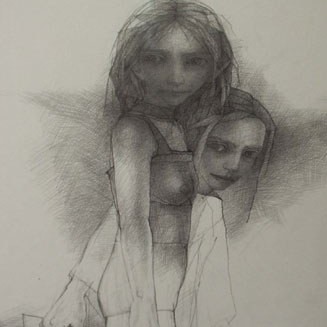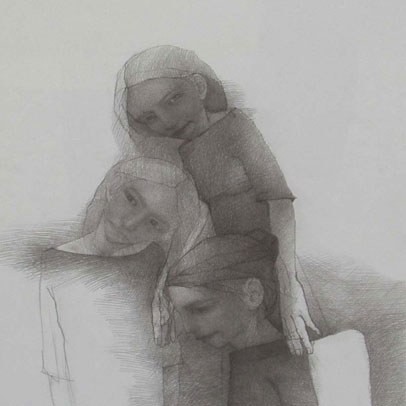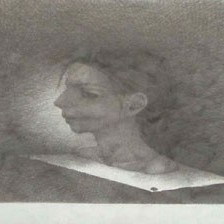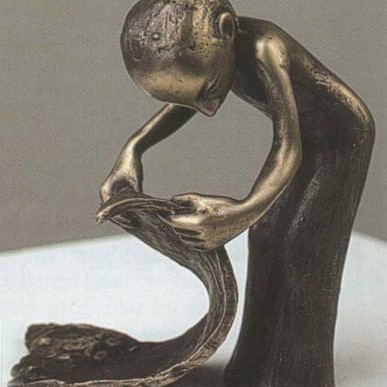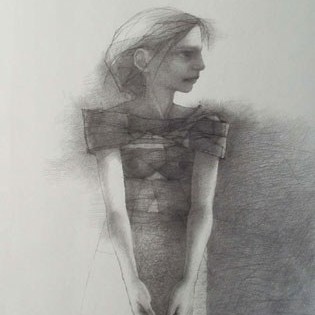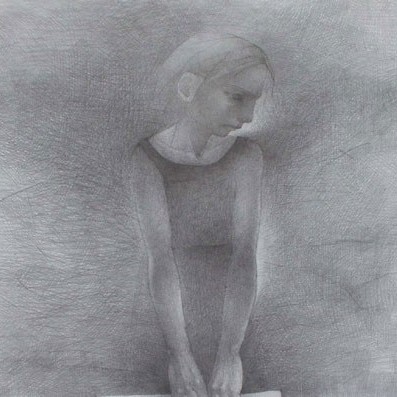Graphic works and small sculptures by Reti Saks.
Reti Saks (1960) graduated in 1987 from the ESAI as a graphical artist. She has had a number of personal exhibitions in France, Germany, Finland, Denmark, Latvia and Estonia. At the exhibition “... draws and depicts ...” the author brings in front of the viewer works, having been made during the last five years, which are talking in a simple and clear language of the important things in life. The artist’s fantasy has always been honest and sincere, depicting perpetually a human being in his/her immediate surroundings.
Opinions of the creation of Reti Saks have been the following:
Small, ascetic figures grow out of treetrunks and act in the surrounding silence in two different ways: from one hand they are as if doing nothing special, from another hand they are doing it with such absorption, seriousness and dedication that everything they are doing should be something of greater importance. This “another hand” can be interpreted as a mental level, maybe a prayer, which for instance in a Medieval monastery accompanied not only serving the God, but each activity: land cultivation, cooking ...Everything is not reachable for us, the earthly ones, but we receive a short message from the spiritual world also through the mediation of the sculptures by Reti, the message, how to step quietly, stand with a thought, embrace a friend with warmth and so cordially that love drips down from one’s fingertips. How to walk deeply in thoughts through walls by converting the surrounding room into a sphere so that its beginning and ending meet in one spot, not paying attention to the fact that it might seem a dislocation to the by-standers. How by touching water to communicate with the Spirit of Water, who lives in the lake behind the city. To read from paper the Word, which says it all. To tiptoe silently with the soul upstairs.
(Vappu Vabar)
An exhibition, being put completely together of only black-and-white graphics, is nowadays quite a rarity. When somebody makes pictures, they are ususally coloured. When the pictures are not coloured, they are also usually not depicting anything; and if they are still depicting something, they are not usually printed graphics, but photography. Black-and-white picture exhibition is a photo exhibition. While taking into consideration the abovementioned, the sheets by Saks seem slightly differing from the general picture.As the style of Saks is extremely laconic and clean, this phenomenon gains well the ascendancy and immediately creates the feeling that we are dealing with a bigger integer, from which the present exhibition forms only one fragment or rather one of its “illuminated sections”.
Comparison with photography is still not quite out of place. Exactly the integer, being created by the pictures, a certain homogeneous room, which opens to us while looking at them, creates again the feeling that we are dealing with “shots”, which have been taken at one spot. The whole creation of Saks is like a black-and-white film, which has been shot in the course of a certain period of time in places, being located in a quite close neighbourhood or corners. (While comparing the present pictures with the earlier ones, one could claim that now we are already using a new film.) These pictures are “shots” of something. The depicted smaller and bigger figures appear in positions, which slightly resemble freezing in front of a camera. The only thing, which conclusively breaks this almost real photo illusion, is the timeless atmosphere of the pictures, their characteristic distancing from the categories of day and night, light and darkness, even of internal and external room.It means that these categories do function, but not in such a manner that they would enable to place the moment of time. Sometimes it feels as if there are day and night simultaneously depicted on one picture; sometimes – that there can not be found either. So it means there exist no moments of time. But still, on the pictures can be seen quite certain scenes, which do not lack analogy with the classical or Medieval art of painting (e.g. the rhetorical expressiveness of arms).
(Hasso Krull)
.png)
